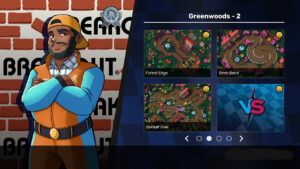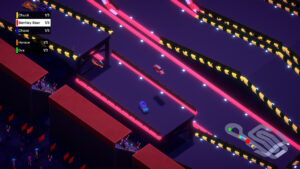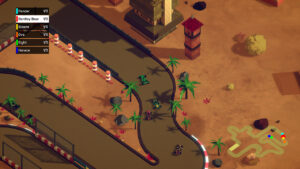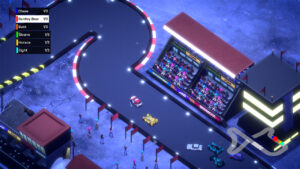The oldest among you may remember the Sprint series, initiated by Atari in the 1970s based on Gran Trak. These top-down racing games delighted arcade players at the time and had several versions allowing up to 8 players to compete on the circuit. The last two versions have also seen some “remixes” on recent consoles. Today, Atari offers us a new version of its racing game, called NeoSprint, with more advanced technology since we are now switching to Isometric 3D. But does the sauce still set? This is what we are going to see!
Sprint, a former Atari success
The first game in the Sprint series, called Sprint 2, was released in November 1976 in arcades; playable alone or in pairs, its main innovation compared to Gran Trak 10 and 20 (two other racing games previously released by Atari), is that the players are not alone on the track. Indeed, other computer-controlled competitors are racing against us. The following year, the publisher released Sprint 4 which, as its name suggests, this time can be played by up to 4 players. And technically, the game is now in color. These two titles will be followed by Sprint 8 (playable up to 8 players, no, it's not the eighth game in the series, take notes, damn it!!!), then by Sprint 1 in 1978 where this time only one player is on the track against opponents controlled by the computer. Finally, in 1986, Super Sprint and Championship Sprint arrived (the latter will also be ported to the consoles of the time and will then introduce the presence of a circuit editor). The last two titles in the series will be entitled years later to ports on PC, Game Boy Advance or even GameCube as part of the Midway Arcade Treasures compilations.
Advertisement
Many years later, Atari is now releasing a new version of its title, this time with an isometric 3D view. Developed by the Headless Chicken studio, based in Costa Rica, this new game is called NeoSprint and notably offers a panel of 9 cars and numerous circuits distributed between four different environments. Playable solo or with up to eight players in local multiplayer, NeoSprint also offers a circuit editor which gives it an appreciable lifespan on paper.
Roll on, little cars!
 After a quick tutorial as an introduction to teach us the basic controls of the game, we are now on the main screen of the title. For solo players, the main mode will be Campaign mode. This consists of three different cups, each comprising four championships. The latter are subdivided into four races of three laps: three races where we are opposed to several opponents controlled by the computer (three for the first cuts, and up to seven for the last), and a final race where we face a single pilot. We will also note a small attempt at scripting at this level, since he gives us a little verbal “jab” before the race to motivate us to beat him. And briefly interacts with us once we cross the finish line.
After a quick tutorial as an introduction to teach us the basic controls of the game, we are now on the main screen of the title. For solo players, the main mode will be Campaign mode. This consists of three different cups, each comprising four championships. The latter are subdivided into four races of three laps: three races where we are opposed to several opponents controlled by the computer (three for the first cuts, and up to seven for the last), and a final race where we face a single pilot. We will also note a small attempt at scripting at this level, since he gives us a little verbal “jab” before the race to motivate us to beat him. And briefly interacts with us once we cross the finish line.
At the end of each championship, and depending on our final ranking, we unlock new liveries for the different cars in the game as well as new track or decor elements for the circuit editor. To return to the possibilities of customizing our car (and our driver), it should be noted that these remain basic since we can only change color, with a few variations since certain liveries offer stripes on the bodywork but that's about it… Finally, the Campaign mode remains short since you will need around 2 to 3 hours of grinding to complete all the cups, a little more if you want to complete all the championships with all the gold medals.
Now let's quickly move on to the other single player modes; we find obstacle races where we find the circuits of the campaign mode with various obstacles to avoid (traffic cones, puddles of oil, etc.) and boosts giving us temporarily more speed, the objective being to beat a given time to obtain a bronze, silver or gold medal. A Time Trial mode which, as its name suggests, consists of establishing the best time on each circuit, is also present as well as a Grand Prix mode where you can not only compete on the circuits already existing in the game, but also “mix” these with our own creations or those of other players. In any case, successes in these different game modes also allow you to unlock new elements for the circuit editor.
Advertisement
And it is precisely this circuit editor, which was initially introduced on the console version of Championship Sprint in 1988, which constitutes one of the major interests of the game. At our disposal, four different environments (forest, desert, snow and city) in which we will be able to exercise our talents as track designers. Featuring a tutorial, this mode is rather intuitive and allows us to create a fairly wide variety of circuits without too much effort. You can choose to make flat paths or, on the contrary, build them on several levels with ramps, bridges, jumps, decorative elements, etc. Likewise, the number of elements available (unlockable via the different solo modes, remember!) allows you to vary the pleasures and only the number of blocks available will be a limit to our creativity! Because yes, it will undoubtedly not be possible to reproduce real circuits like the Nürburgring or the Le Mans circuit, but the range is wide enough to have fun, especially since we can also discover as said more top the creations made by other players, which suddenly opens up a lot of possibilities!
Simple and enjoyable gameplay
 Console or Joy-Con in hand(s), handling is easy and driving the different cars is very easy to understand, another very good point from NeoSprint. The controls are basic, since the left Joy-Con joystick is used to steer your car, and the A, B, crash) and use the handbrake. Finally, the L key is used to identify your car and its position during a race. Regarding the buttons, and even if you get used to it in the long run, we still regret that B is used to brake and Y to use the handbrake: you will undoubtedly brake at first (and it brakes hard! ) while skidding would have made you waste less time… Likewise, some of you would also have found it interesting to be able to reassign the keys so as to use the ZL and ZR triggers for the accelerator and the brake.
Console or Joy-Con in hand(s), handling is easy and driving the different cars is very easy to understand, another very good point from NeoSprint. The controls are basic, since the left Joy-Con joystick is used to steer your car, and the A, B, crash) and use the handbrake. Finally, the L key is used to identify your car and its position during a race. Regarding the buttons, and even if you get used to it in the long run, we still regret that B is used to brake and Y to use the handbrake: you will undoubtedly brake at first (and it brakes hard! ) while skidding would have made you waste less time… Likewise, some of you would also have found it interesting to be able to reassign the keys so as to use the ZL and ZR triggers for the accelerator and the brake.
Regarding the different cars (Formula 1, Sport Prototype, Muscle Car, etc.), there are no big differences in road behavior, essentially you will have to juggle between the three parameters that define them (acceleration, speed maximum and maneuverability) in order to find the ideal mount for this or that circuit or championship. As for the camera, it can be focused on the circuit and fixed, revealing the entire circuit on the screen, or centered on our car in which case it will be closer to the track and will follow our progress during the races. The first type of camera will be used almost exclusively in docked mode, and on a good-sized screen, because in portable mode it is very difficult to read. As for the second, it is however perfectly suited for nomadic use. The fact remains that in both cases, two concerns arise; on the one hand, the circuits can be on several different levels, our vehicle and the track are not necessarily very visible when we pass under a bridge and there is a bend, for example: the visibility is too reduced, limited to a hole in the upper part where we could barely see our machine, and we quickly hit the edges of the track and lost precious time. On the other hand, circuits sometimes include jumps, ramps and/or banked turns. And the isometric view without changing camera angles is not ideal for understanding terrain deformations…
Technically off the mark…
 Now let's talk about the things that really annoy you. Starting with the realization: the graphics, without being bad, do not do justice to the Nintendo Switch whether in docked or portable mode. Certainly, there are small animations at the edge of the track with for example animated chairlifts on the edge of snowy circuits, snowflakes which seem to fall on the screen and also some welcome effects like this vortex when you take the vacuum. of a birthday or even the smoke that comes from the tires when we skid or from the engine when we kissed too much at the barriers. In terms of good notes, know that NeoSprint offers us a very nice slow-motion “photo finish” when you finish a race neck and neck with an opponent. But the fact remains that there remains a persistent overall blur on the screen during the races which ends up being unpleasant. Clearly, in 2024, the Switch can do much better! Furthermore, if the framerate does not pose a problem on “simple” circuits, the same is not true as soon as there are too many elements (decor, opponents, smoke effects or others) at the same time. screen, and we can then note some very marked jerks. In terms of good points, we note however that the loading times between races are very fast, around 4 to 5 seconds, which is perfectly suited to this style of game which focuses above all on games fast and nervous.
Now let's talk about the things that really annoy you. Starting with the realization: the graphics, without being bad, do not do justice to the Nintendo Switch whether in docked or portable mode. Certainly, there are small animations at the edge of the track with for example animated chairlifts on the edge of snowy circuits, snowflakes which seem to fall on the screen and also some welcome effects like this vortex when you take the vacuum. of a birthday or even the smoke that comes from the tires when we skid or from the engine when we kissed too much at the barriers. In terms of good notes, know that NeoSprint offers us a very nice slow-motion “photo finish” when you finish a race neck and neck with an opponent. But the fact remains that there remains a persistent overall blur on the screen during the races which ends up being unpleasant. Clearly, in 2024, the Switch can do much better! Furthermore, if the framerate does not pose a problem on “simple” circuits, the same is not true as soon as there are too many elements (decor, opponents, smoke effects or others) at the same time. screen, and we can then note some very marked jerks. In terms of good points, we note however that the loading times between races are very fast, around 4 to 5 seconds, which is perfectly suited to this style of game which focuses above all on games fast and nervous.
The AI is also of a very good level in single-player mode, since your competitors are not fixed on a fixed trajectory and make mistakes from time to time. Errors which can sometimes help you to overtake them, but which can also penalize you if they ever hit you!
The soundtrack area blows hot and cold; the music present in the different menus and during the races is not bad, far from it (Editor's note: it reminds us personally a little of that of Art Of Rally). On the other hand, there are very few of them and the theme at the end of the race remains the same, regardless of whether you finish first or last. Finally, during the race, the melodies still have the good taste of remaining at a sufficiently low sound level, without having to touch the settings, to remain appreciable and not end up hitting the system… On the other hand, the sound of the cars is catastrophic, almost sending us back to the era of the NES, just like that of the collisions which is also a little too marked… In terms of sound effects, we will only be able to save the few effects which accompany the aspiration phases during the race, which are as for them, welcome and friendly.
NeoSprint is available at the price of twenty-five euros on theeShop.
Conclusion
MOST
- The rather complete and intuitive circuit editor
- Discreet but pleasant music
- Easy to handle
- Fast loading times making quick games easier
- Very fun in multiplayer
THE LESSERS
- Price way too high for the content
- Production sorely lacking in care
- Single player mode quite short and above all very repetitive
- Sounds of different cars and collisions very poor
- Customization of mechanics and anecdotal drivers
